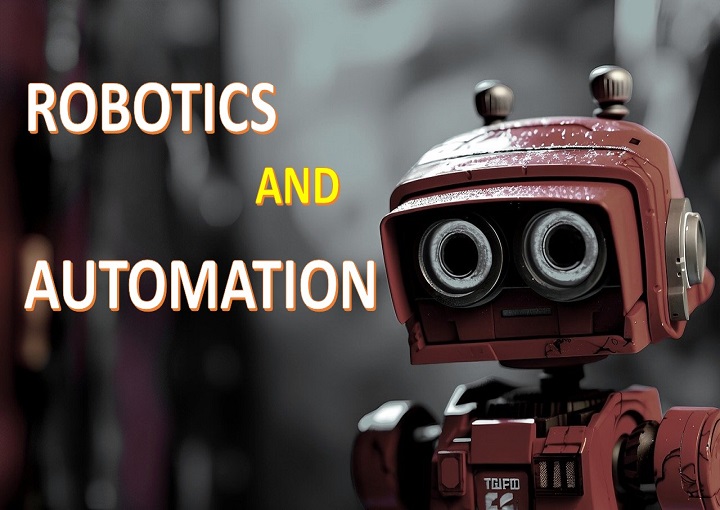Explore the world of robotics and automation, where cutting-edge technology meets innovation. Uncover the endless possibilities and advancements in robotics, from industrial automation to artificial intelligence. Discover how robots are transforming industries, improving efficiency, and revolutionizing the way we work. Dive into topics such as machine learning, sensor technology, and autonomous systems, and stay updated on the latest trends and breakthroughs in the field. Join the robotics revolution and witness the future unfold before your eyes
Introduction
Robots and automation have become an integral part of our modern world, revolutionizing various industries and transforming the way we live and work. From manufacturing to healthcare, robotics and automation have proven to be powerful tools, improving efficiency, precision, and safety. In this article, we will delve into the fascinating world of robotics and automation, exploring their definition, applications, benefits, challenges, and the future they hold.
What is Robotics?
A. Definition
At its core, robotics refers to the design, creation, and operation of robots. Robots are programmable machines that can perform tasks autonomously or with minimal human intervention. They are equipped with sensors, actuators, and sophisticated algorithms that enable them to interact with the physical world and make decisions based on the data they collect.
B. Types of Robotics
There are various types of robotics, each designed for specific purposes. Industrial robotics focus on automating tasks in manufacturing and assembly lines. Service robotics aim to assist humans in everyday tasks, such as cleaning robots or personal assistants. Social robotics explores the interaction between robots and humans, often used in research or entertainment. Medical robotics plays a crucial role in surgical procedures, enhancing precision and minimizing invasiveness.
Applications of Robotics
A. Industrial Automation
One of the most prominent applications of robotics is in industrial automation. Robots have transformed manufacturing processes, improving productivity, quality control, and worker safety. They can handle repetitive tasks with high precision, work in hazardous environments, and operate continuously without fatigue. Industries such as automotive, electronics, and pharmaceuticals heavily rely on robotic automation to meet the demands of mass production.
B. Healthcare
Robotics and automation have revolutionized healthcare, enabling advancements in diagnosis, surgery, and patient care. Surgical robots assist surgeons in performing complex procedures with enhanced precision and minimal invasiveness. Robots are also used in rehabilitation therapies, assisting patients in regaining mobility. Additionally, robotic exoskeletons help individuals with disabilities to enhance their mobility and quality of life.
C. Agriculture
The agricultural sector has also embraced robotics and automation to increase efficiency and address labor shortages. Robots are employed in tasks like planting, harvesting, and monitoring crops. They can accurately analyze soil conditions, apply fertilizers, and perform precise pesticide spraying. With the help of robots, farmers can optimize yields, reduce resource wastage, and achieve sustainable agriculture practices.
D. Exploration and Space
Robots are vital in exploration and space missions, enabling us to gather information from distant and inhospitable environments. Robotic rovers, like NASA’s Mars rovers, have successfully explored other planets, collecting valuable data and images. These robots withstand extreme conditions and perform scientific experiments, expanding our understanding of the universe.
Benefits of Robotics and Automation
The integration of robotics and automation brings numerous benefits to various sectors:
- Increased productivity and efficiency
- Improved quality control and accuracy
- Enhanced worker safety by handling hazardous tasks
- Reduction in labor costs and optimization of resources
- Ability to perform tasks continuously without fatigue
- Precision and minimally invasive surgical procedures in healthcare
- Exploration of hazardous and unreachable environments
- Assistance in everyday tasks for individuals with disabilities or elderly
Challenges and Limitations
While robotics and automation offer immense potential, they also come with their fair share of challenges and limitations. Some of the key considerations include:
1. Cost:
Implementing robotics and automation systems can require significant upfront investment. The cost of purchasing, integrating, and maintaining robots may pose financial challenges for smaller businesses or organizations.
2.Complexity:
Developing and programming robots can be complex and time-consuming. It requires expertise in robotics, engineering, and software development. Additionally, maintaining and upgrading robots to keep up with technological advancements can be a continuous challenge.
3. Workforce Displacement:
The increased use of robots and automation in certain industries raises concerns about potential job displacement. While automation can streamline processes and improve efficiency, it may lead to reduced employment opportunities for some workers.
4. Limited Adaptability:
Robots excel at performing repetitive tasks in controlled environments. However, they often struggle with tasks that require adaptability, problem-solving, or handling unexpected situations. Human intervention may still be necessary for complex decision-making.
5. Ethical Considerations:
As robotics becomes more sophisticated, ethical considerations arise. Questions about privacy, security, and the ethical use of robots in various scenarios need to be addressed to ensure responsible and beneficial deployment.
Future of Robotics
The future of robotics holds tremendous promise. Here are some exciting developments on the horizon:
1. Collaborative Robots:
The emergence of collaborative robots, or cobots, is revolutionizing human-robot interaction. These robots can work alongside humans, assisting them in tasks, and improving overall productivity and safety.
2. Artificial Intelligence Integration:
Advancements in artificial intelligence (AI) are enhancing the capabilities of robots. AI algorithms enable robots to learn, adapt, and make decisions in real-time, leading to more intelligent and autonomous systems.
3. Personal Robotics:
Personal robots designed for home use are becoming increasingly common. These robots can assist with chores, provide companionship, or even serve as educational tools for children.
4. Swarm Robotics:
Swarm robotics explores the concept of coordinating large groups of small robots to work together effectively. This field has the potential for various applications, including disaster response, environmental monitoring, and logistics.
5. Humanoid Robots:
Humanoid robots aim to replicate human-like characteristics, both in appearance and behavior. These robots could find applications in fields such as customer service, healthcare, and entertainment.
As technology continues to advance, robotics and automation are poised to reshape various industries and transform our daily lives.
Conclusion
In conclusion, robotics and automation have emerged as powerful tools with a wide range of applications. From industrial automation to healthcare and space exploration, robots have revolutionized the way we work, live, and explore. While there are challenges to overcome, the benefits and potential of robotics are undeniable. As we look to the future, advancements in AI, collaborative robots, and personal robotics will continue to push the boundaries of what robots can achieve. It is an exciting time where humans and robots can collaborate, leveraging their unique strengths to create a more efficient, safer, and innovative world.
FAQs
1. Are robots going to replace human workers completely?
Ans. Robots are unlikely to replace human workers completely. While automation may lead to job shifts and changes, there will still be a need for human skills, creativity, and decision-making in many industries.
2. Can robots have emotions?
Ans. Currently, robots do not possess emotions in the same way humans do. However, researchers are exploring the field of social robotics to create robots that can recognize and respond to human emotions.
3. How safe are surgical robots?
Ans. Surgical robots undergo rigorous testing and are designed to enhance safety in surgical procedures. They offer precise movements and enhanced visualization, reducing the risks associated with traditional surgery.
4. What are the potential ethical concerns related to robotics and automation?
Ans. Ethical concerns include issues of privacy, security, and the responsible use of robots. There are debates surrounding the ethical implications of robots replacing human workers, as well as questions about the use of autonomous robots in sensitive situations, such as warfare.
5. How can robotics benefit the agriculture industry?
Ans. Robotics can benefit agriculture by automating tasks such as planting, harvesting, and monitoring crops. Robots can optimize resource usage, improve efficiency, and enable precision farming techniques. This leads to increased yields, reduced environmental impact, and sustainable agricultural practices.

